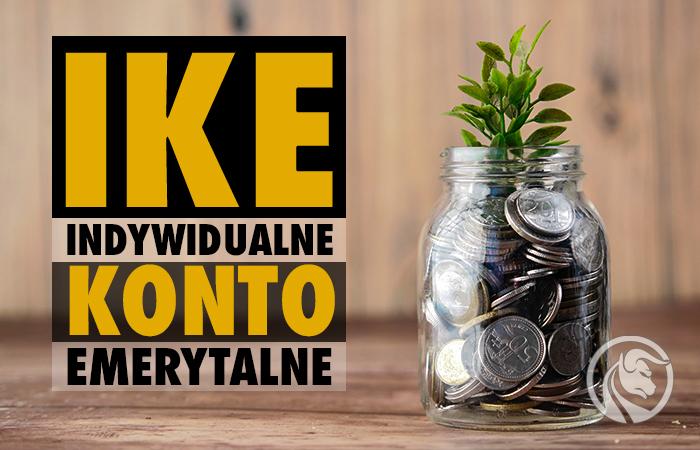Individual Retirement Account (IKE) – a way to build retirement savings
The reform of the pension system in Poland, which took place at the end of the XNUMXth century, made the security ewas to be based on three pillars: two mandatory i one voluntary. Obligatory pillars (I and II) are funds credited to the account of the Social Insurance Institution (ZUS) and funds invested with OFE (Open Pension Funds). These two pillars were fed from the employee's salary. Thus, these were funds paid by the employer and the employee. It was the first and second pillars and the reforms related to them that attracted the attention of the society and the media. The third pillar was left alone. What's worse, most people don't realize how tax-friendly the voluntary insurance schemes are. In today's article, we'll tell you what it is Individual Retirement Account (IKE) and what are its advantages and disadvantages. We invite you to read!
Why is it worth saving?
Saving money is a must for people who do not have a large net worth. For most people, the primary source of generating cash is paid work. This stream of money is mostly used for consumption. Instead of generating surplus funds and building their capital, people use additional funds to go to expensive restaurants, travel abroad or purchase premium utility items. Consumption itself is not bad, but it cannot be beyond the financial capacity of the household. A special role in promoting such a consumer lifestyle is played by social media, which fuel the desire to buy products that most consumers cannot afford.. This means that many people who are able to take care of their future focus on lavish life. Living in apparent luxury is a road to nowhere.
In the construction of property, the most important are:
- Having a minimum fund to protect against sudden expenses;
- Repayment of high-interest consumer debts;
- Building a security fund: an amount equal to 6 months' expenses;
- Open a retirement account;
- Overpay your mortgage;
- Further multiplication of wealth and raising the standard of living.
Savings provide, firstly, security and protection against unexpected expenses and a safety buffer against job loss. The largest component of savings should be for retirement funds. It is then that additional funds will be needed to maintain the current standard of living. Moreover, a large net worth will allow you to consume more luxurious products without having to take on debt or deplete your savings too much. It is worth saving wisely and using all available products that allow you to reduce the effective tax rate.
Taxes - one of the enemies of the saver
There are only two certainties in the world: death i taxes. Taxes are an often overlooked aspect of investing. They have a significant impact on the rate of return on investment. A problem that is often overlooked is the tax issue in the light of compound interest. Postponing tax at the end of the investment period allows you to increase the effective rate of return on investment.
Let's take the following example. Investor A invests $50 in ETFwhich reinvests its funds (does not pay dividends). The aforementioned ETF generates a 9% rate of return. The investor holds the position for the next 30 years. Investor B invested $50 in the stock market. It generates a 000% average annual rate of return and pays 9% tax each year. Investors generate the same rate of return on average per year. The only difference is when the capital gains tax will be paid.
| Investor A | Investor B | |
| Initial amount | $ 50 | $ 50 |
| Amount after 30 years | 546 841 $ | 412 807 $ |
As you can see, the difference in the tax payment at the end of the investment or the tax payment at the end of each year is very large. Therefore, it is worth analyzing carefully whether there is a possibility of tax optimization and tax deferral.
Tax and inflation
Moreover, paying the tax every year reduces the real rate of return on investment, which is calculated by adjusting the profitability for the rate of inflation. Because the tax is calculated on nominal profit, not real profit.
For example:
An investor invested PLN 100 in a bond with an interest rate of 000%. Inflation is 4% and capital gains tax is 2,5%. What will be the real profit from this transaction? The nominal gross profit amounted to PLN 19. The tax on profit amounted to PLN 4000 (760%*19). Inflation consumed PLN 4000 (2500% * PLN 2,5). This means that the real profit was PLN 100, which is only 000%. If the investor had deferred the tax, the real rate of return would be 740%.
IKE – defer tax and build savings
In the further part of the text, we will focus on IKE, which can be one of the sources of retirement security.
The Individual Retirement Account is an interesting product that allows you to defer capital gains tax payments. In some cases, it is possible to completely avoid the tax. IKE is an opportunity for legal tax optimization.
The concept of the Individual Retirement Account was developed in the late 1s, but the IKE came into force only on September 2004, 2008. Until 1,5, the maximum annual payment to the account was 2005 times the average monthly salary. In 3,6, a person could pay PLN XNUMX thousand to the Individual Retirement Account. zlotys. Since 2009, the payment limit has been raised to 3 times the average monthly salary.
Pursuant to the Act, the right to make payments to IKE is vested in a natural person who has reached the age of 16. It is worth remembering, however, that minors (aged 16-18) have a very limited right to make payments to the Individual Retirement Account. Such persons can make payments only if they earn income under an employment contract. An additional source of payments to the account for a minor are funds inherited from the deceased IKE account holder. Then it is possible to transfer funds to the account of a minor.
An Individual Retirement Account may belong to only one person. For this reason, it is not possible to create joint or matrimonial accounts. Therefore, if a family wants to increase the level of tax optimization, it must set up individual accounts for each family member who can do so.
Before signing an agreement with a financial institution regarding an Individual Retirement Account, the person setting up the account must declare that he does not have another IKE. If a person already has an IKE, he must choose where the funds are to be accumulated. A person cannot accumulate funds on more than one IKE. These are the restrictions that result from the law.
The second statement concerns the fact that the person did not transfer funds from another IKE held to an occupational pension scheme (PPE). What's more, people who are over 55 must declare that they have not made withdrawals from the Individual Retirement Account in the past.
Pursuant to the Act, Individual Retirement Accounts may be maintained by:
- Investment funds (open-ended investment funds, specialized investment funds);
- Entities conducting brokerage activities (brokerage houses, banks conducting brokerage activities);
- life insurance companies;
- banks;
- Voluntary pension funds (from 1 January 2012).
Signing an agreement with an investment fund
What are the benefits of IKE if it is opened in an investment fund? The most important of them is exemption from capital gains tax when a person redeems his participation units. This allows the IKE owner to freely allocate his capital to various funds. Without an IKE account, any redemption or conversion of funds would result in the need to pay capital gains tax. This type of IKE accounts allows you to earn on the increase in the value of participation units and generate a higher effective rate of return on investment.
IKE in an institution conducting brokerage activities
By choosing this offer, the client has the option of investing in securities listed on organized and regulated trading venues. As with other accounts, the payment of capital gains tax is deferred. A brokerage account enables individual purchases of shares or bonds for an investment portfolio. Thanks to the tax deferral, the investor receives a higher effective, average annual rate of return on investment.
IKE at the Life Insurance Company
Such a contract is signed under life insurance in conjunction with an insurance capital fund. In the signed contract, the client agrees with the insurance company what part of the amount will be covered by the insurance and what part will be invested in the insurance capital fund under the IKE account. Before signing the contract, it is worth checking what the costs are in the event of premature termination of the UFK (Insurance Capital Fund).
IKE as a savings account
This type of Individual Retirement Account can only be offered by domestic banks (operating in Poland and regulated by the Polish Financial Supervision Authority). It is an offer addressed to customers who expect the safest offer to multiply their savings. The interest rate on such accounts is not high, but the advantage is that no capital gains tax is withheld.
Transfer between institutions running IKE and PPE
Of course, signing the IKE contract does not bind the client for life. At any time, the IKE owner may transfer them to another financial institution. What's more, you can also transfer funds between IKE and the Employee Pension Scheme. This transfer of funds is exempt from capital gains tax. It is worth remembering, however, that financial institutions may demand a fee for the transfer of funds between IKE accounts if it takes place within 12 months of signing the contract. The fee is not mandatory, it depends on the policy of the financial institution. Before signing the contract, the customer should have access to the full IKE maintenance price list.
The Act only allows for the transfer of all accumulated assets. Of course, exceptions are allowed. Among them is the transfer of funds between different investment funds belonging to the same "family" of funds (to the offer of one TFI). Another exception is that the transferred funds are in liquidation or bankruptcy proceedings.
When a person has decided to transfer the accumulated capital to another entity, he must conclude an agreement for the maintenance of a new Individual Retirement Account before making the transfer. According to the Act, the transfer of funds is to take place within 14 days from the date of submitting the instruction to transfer assets between IKE accounts. A similar time applies to the transfer between IKE and PPE.
Withdrawal of funds from IKE
According to the assumptions, IKE was established to collect additional funds to help seniors during their retirement. For this reason, tax credits are designed to discourage quick withdrawals. Tax credits are greatest for those over 60. If someone acquired the right to an old-age pension earlier, the tax relief will appear only after the IKE owner turns 55.
In addition, in order to be entitled to exemption from capital gains tax, the following conditions must be met:
- Payments to IKE were made in at least 5 any calendar years (there is no obligation to pay in each subsequent year);
- More than half of the value of payments to IKE had to be made at least 5 years before the date of submitting the withdrawal request by the person.
There are additional exceptions to these conditions. Persons born before December 31, 1948 have a shorter savings period, which entitles them to a tax exemption. For those born before December 31, 1945, the 5-year period was shortened to 3 years. For people from 1946-1948, the minimum saving period was set at 4 years.
Before making a payment, the financial institution (which runs the IKE) must be provided with the relevant tax office. If the saver is under 60 years of age, he must present the decision of the competent authority to grant the old-age pension.
Please note that if a one-off payment is made, you cannot re-establish an IKE, as the tax exemption for savings is a one-off. Therefore, the decision to liquidate IKE should be carefully considered. If the payment is made in installments, after the first installment has been made, the saver cannot make payments to the Individual Retirement Account.
Early withdrawal of funds from IKE
The saver may earlier withdraw the accumulated funds from the Individual Retirement Account at any time. This involves paying capital income taxwhich is currently 19%. The right to withdraw part of the funds has been granted since 1 January 2009. Before that date, it was impossible.
Can IKE funds be nationalized?
There have been many myths about IKE over the years. One of the most damaging concerns was the nationalization of funds accumulated in pension accounts in connection with the reforms of the pension system carried out by the PO-PSL and PiS coalition.
Many people are skeptical about products from the third pillar because they remember the behavior of governments that "tinkered" with open pension funds. At the very beginning, the bond part of OFE went to "individual ZUS accounts" and then the next government offered people the right to transfer funds either to IKE or to a ZUS account. It is worth noting, however, that the funds accumulated in OFE came from pension contributions, which were paid jointly and severally by employees and employers. Therefore, the transfer of funds from OFE to ZUS was theoretically a transfer of public funds. In the case of IKE, we are talking about the private savings of Poles. For this reason, an increase in IKE assets does not result in an increase in the public finance deficit.
Currently, there is no major threat of nationalization of funds accumulated in IKE. At least in the near future. Such a threat would arise in a situation when a party came to power that would like to nationalize private property. In this case, it will not matter whether the assets are stored in a bank, brokerage account or IKE. The probability of such a scenario is currently close to zero. The economic views of the main parties operating in Poland should be monitored. For the time being, none of the major parties has a communist view of the economy. Therefore, it is not worth postponing the decision to join IKE in order to take advantage of the tax benefits.






















![Forex Club – Tax 9 – Settle tax on a foreign broker [Download the Application] Forex Club - Tax 9](https://forexclub.pl/wp-content/uploads/2024/02/Forex-Club-Podatek-9-184x120.jpg?v=1709046278)
![Trading View platform – solutions tailored to the needs of traders [Review] trading view review](https://forexclub.pl/wp-content/uploads/2024/03/trading-view-recenzja-184x120.jpg?v=1709558918)
![How to connect your FP Markets account to the Trading View platform [Guide] fp markets trading view](https://forexclub.pl/wp-content/uploads/2024/02/fp-markets-trading-view-184x120.jpg?v=1708677291)
![How to invest in ChatGPT and AI? Stocks and ETFs [Guide] how to invest in chatgpt and artificial intelligence](https://forexclub.pl/wp-content/uploads/2023/02/jak-inwestowac-w-chatgpt-i-sztuczna-inteligencje-184x120.jpg?v=1676364263)


![WeWork – the anatomy of the collapse of a company valued at $47 billion [WeWork, part II] wework bankruptcy story](https://forexclub.pl/wp-content/uploads/2024/04/wework-bankructwo-historia-184x120.jpg?v=1711729561)
![Adam Neumann – the man who screwed up Softbank [WeWork, part AND] adam neumann wework](https://forexclub.pl/wp-content/uploads/2024/04/adam-neumann-wework-184x120.jpg?v=1711728724)





![How to transfer shares to another brokerage office [Procedure description] how to transfer shares to another brokerage house](https://forexclub.pl/wp-content/uploads/2024/03/jak-przeniesc-akcje-do-innego-biura-maklerskiego-184x120.jpg?v=1709556924)

![The most common mistakes of a beginner trader - Mr Yogi [VIDEO] Scalping - The most common mistakes of a beginner trader - VIDEO](https://forexclub.pl/wp-content/uploads/2024/03/Scalping-Najczestsze-bledy-poczatkujacego-tradera-VIDEO-184x120.jpg?v=1711601376)
![Learning patience: No position is also a position - Mr Yogi [VIDEO] Scalping - Learning patience - No position is also a position - VIDEO](https://forexclub.pl/wp-content/uploads/2024/03/Scalping-Nauka-cierpliwosci-Brak-pozycji-to-tez-pozycja-VIDEO-184x120.jpg?v=1710999249)
![When to exit a position and how to minimize losses - Mr Yogi [VIDEO] Scalping - When to exit a position and how to minimize losses - VIDEO](https://forexclub.pl/wp-content/uploads/2024/03/Scalping-Kiedy-wyjsc-z-pozycji-i-jak-minimalizowac-straty-VIDEO-184x120.jpg?v=1710336731)

















